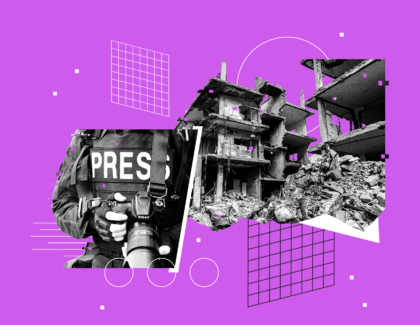Sign up for the daily CJR newsletter.
A humanitarian crisis and murderous terrorism abroad; natural disaster and pandemic mass death at home. Even by its recent, dreadful standards, the news cycle is especially hellish across an especially wide range of fronts right now, and journalists and their editors must balance the horrors. The Delta variant of the coronavirus has continued to ravage the US, and yet, in recent weeks, much media attention has been diverted to Afghanistan, where the Taliban has taken control; on Thursday, amid a crush to evacuate at Kabul’s airport and sharp warnings of a terror threat there, a regional affiliate of ISIS carried out a highly deadly suicide bombing outside the gates. Then, yesterday, Hurricane Ida—a historic storm that, as the Washington Post put it, looks like “the poster child for a climate change-driven disaster”—made landfall in Louisiana, causing severe flooding, tearing roofs off buildings, and knocking out power, including across the whole of New Orleans. Powerlessness might also describe a dominant mood in coverage of this rush of tragedies—or, at least, the feeling one has on taking it all in.
One way that news organizations try to get their arms around massive stories like these is to quantify them. Numbers really started to drive the Afghanistan conversation in the US a week or so ago, as the Biden administration and its allies argued that they deserved more media credit for exceeding even their own evacuation expectations, and journalists debated the impressiveness of the figures and the extent to which they offset criticisms of the withdrawal; then came Thursday’s attack and a much grimmer counting exercise, as the death toll among US service members climbed from some to twelve to thirteen, and the death toll among Afghan civilians climbed from more than sixty to more than ninety to more than a hundred and seventy and rising. Big-picture COVID coverage—always a grim counting exercise, whatever the accuracy of the counting—is starting to crystallize around US hospitalization and death rates that are at their highest levels in months and have just peaked beyond round-number yardsticks (more than a hundred thousand and more than a thousand per day, respectively), as well as alarming new death projections. COVID numbers have shown up in Ida coverage, too, thanks to Louisiana’s relatively low vaccination rates, relatively high hospitalizations and deaths, and low spare hospital capacity. As the storm approached, we heard a lot, too, about its category status (Four but dangerously close to Five). Overnight, Ida became a death story in its own right—its first victim confirmed after a tree fell on a house in Ascension Parish, south of Baton Rouge.
ICYMI: Politico, Vice, and the circular digital-news story
This isn’t to say, of course, that the coverage of these stories has been reduced to numbers, or that the numbers haven’t been helpful. If it’s hard to avoid the feeling that numbers are inadequate to communicate human suffering, that’s a fault of human suffering as much as one of media coverage; nor is any of this a new observation. Still, the combined depth and breadth of the suffering in the news right now gives the observation a fresh sharpness. Watching the conversation around the rising evacuation numbers failed to alleviate my sense of hopelessness—each person saved is a good-news story, but the sheer weight of life left behind remains crushing. It has felt difficult, too, to reconcile the media anguish around the Kabul bombing and the relative relegation of COVID anguish in the US—a reflection not on the tragedy of the former, but the numbness which, in many quarters, now seems to greet still-awful COVID death figures. (Not that the numbness is new, either.) If numbers are inadequate to communicate suffering, then it makes little sense to say that attention should follow death rates in exact proportion—indeed, that feels monstrous. But it seems clear that the media, as a whole, is better equipped to cover new and shocking causes of deaths than the ones we got used to.
A related question here, which perhaps bears even more directly on the media, is that of the lives we choose to humanize beyond the numbers. Once the service members killed in Kabul had been identified, the US media—rightly—swelled with devastating tributes that highlighted their youth and the lives they left behind. There have also been some tributes to Afghans who died in the attack—the Post’s Ezzatullah Mehrdad and Sudarsan Raghavan, to cite one example, profiled four of them, including a journalist named Ali Reza Ahmadi; Marcus Yam of the LA Times, to cite another, photographed a funeral—but these have been fewer; the Afghan victims’ names weren’t read out on the Sunday shows. There are sharp difficulties in telling their stories—not least the dangers faced by journalists, and their sources, in Afghanistan right now—but it’s hard to conclude that logistics are the only reason for the disparity in attention, at the end of a war whose many Afghan victims have been all but lost to the news cycle, despite diligent work by some reporters on the ground. “No one asks about us,” a man named Jamil, whose brother was killed last week, told Nabih Bulos, of the LA Times. “All the newspapers and all the magazines spoke about the American troops that were killed. It’s frustrating, because Afghan murder, Afghan dead, Afghan blood—it’s not important.”
Yesterday morning, US news organizations aired early reports of another explosion in Kabul, which turned out to be a US drone strike on a vehicle that, officials said, posed an imminent threat to the airport. Major outlets parroted the military line that there were no “initial indications” of civilian casualties—but more skeptical observers expressed reservations, and as time passed, reports started to filter through that the military line was indeed wrong. (“The journalists who still blindly regurgitate and even celebrate official claims about killing terrorists in these strikes are just mouthpieces at this point,” Murtaza Hussain, who writes for The Intercept, tweeted yesterday. “It’d be preferable if they just cut out the middleman and applied to work in public relations for the Pentagon or CIA.”) CNN, citing a journalist on the ground, has now reported that the drone strike killed nine members of a single family, six of them children. The story is still developing, and will need to be watched carefully for the dynamics noted above.
The Ida story is still developing, too; the hurricane is now a tropical storm, but the danger has not passed, and the full scale of the damage remains to be seen. We have already seen journalism humanizing the cost, especially from local outlets, and can expect to see more of it—but media watchers have expressed fears, too, that some of the coverage will stigmatize the unhoused and those who chose not to evacuate as well as marginalizing the voices of people of color, fears that are well founded. One figure that has recurred in the coverage so far has been sixteen, the number of the years to the day between hurricanes Katrina and Ida; numerous outlets framed the latter storm as the biggest test of New Orleans’s flood defenses since they failed so disgracefully against the former. As Floodlines, an Atlantic podcast hosted by Vann R. Newkirk II, reminded us last year, sections of the media also failed in the aftermath of Katrina, spreading racist misinformation about “looting and lawlessness” on the ground. We now have better access to accurate, round-the-clock information. But the media’s mistakes during Katrina still convey a timeless lesson: that when disaster strikes, we have a great deal of power after all.
Below, more from this hellish news cycle:
- Afghanistan: Yesterday, news networks broadcast from Dover Air Force Base, in Delaware, as the remains of the thirteen service members killed in Kabul last week were repatriated in the presence of Biden and their families. As CNN’s Kaitlan Collins pointed out on air, the Pentagon has only allowed the press to broadcast images of the process of repatriation, which is known as “dignified transfer,” since 2009, and victims’ families are still asked to sign off on the media’s presence; on this occasion, the families of eleven of the Kabul victims consented, while the families of the other two requested privacy.
- Ida, I: Yesterday, Al Roker appeared on NBC’s Meet the Press from Lake Pontchartrain, in Louisiana, as waves crashed against him. The clip, and others like it, attracted some criticism online. “Can we please end the normalization of putting meteorologists and reporters at risk during extreme weather events?” Kat Stafford, an AP reporter, tweeted. “What purpose does it serve, aside from shock value, for viewers who need vital information in this moment?” Roker later responded to the critics in a post on Instagram. “For all those who were worried about me out on #lakepontchartrain,” he wrote, “a) I volunteered to do this. Part of the job. b) My crew and I were safe and we are back at our hotel and c) for those who think I’m too old to to be doing this, try and keep up.”
- Ida, II: Local outlets in Louisiana continued their coverage after the storm hit, in the face of severe obstacles, including the loss of power; WGNO, a TV station in New Orleans, partially evacuated its newsroom and studios after Ida damaged the roof, leaving water to penetrate the building. As CNN’s Brian Stelter reports, social media and other forms of technology have enabled news outlets to follow extreme weather events in ways that weren’t possible before. Yesterday, “reporters weren’t embedded in coastal and low-lying areas because the danger was simply too great, so webcams were the main way to assess the damage,” he writes. “Some locations lost power and/or internet connectivity during the storm, but an impressive number of the cameras remained online.”
- The pandemic: In an article for The Atlantic, Céline R. Gounder, an epidemiologist, makes the case that Americans are “losing sight of the pandemic endgame.” Americans “have to recalibrate our expectations about what makes a vaccine successful,” Gounder writes. “The public discussion of the pandemic has become distorted by a presumption that vaccination can and should eliminate COVID-19 entirely. Under such an unattainable standard, each breakthrough infection looks like evidence that the vaccines are not working. But in reality, they continue to perform extremely well.”
Other notable stories:
- According to Lachlan Markay, of Axios, at least sixteen Biden administration officials have obtained ethics waivers that allow them to do government work that may intersect with entities that employed or paid them in the past; four officials—Jennifer Granholm, the energy secretary; Pete Buttigieg, the transportation secretary; and Wendy Sherman and Victoria Nuland, both of whom work at the State Department—got waivers enabling them to speak to news organizations who formerly paid them or a spouse. As Markay notes, the Biden waivers are, for the most part, “qualitatively distinct” from many of those granted under Trump, which permitted officials to work with former lobbying clients.
- Politico’s Playbook team reports that Andrew Cuomo—the former New York governor who, while in office, used the media “as a tool to inspire fear and sow mayhem”—plans to continue doing so as a private citizen, mounting “a campaign of retribution against his perceived political enemies” including his successor as governor, Kathy Hochul. Cuomo has already tapped into an eighteen-million-dollar war chest to rehire Rich Azzopardi, his longtime spokesperson who, per Playbook, already tried to plant negative stories about Hochul and others as Cuomo prepared to leave office. (Azzopardi denies this.)
- Earlier this month, Dan Darling, a spokesperson for the National Religious Broadcasters, a group that aims to spread the Gospel of Jesus Christ through media, appeared on Morning Joe, on MSNBC, and explained how his faith motivated him to get vaccinated. Darling’s bosses subsequently accused him of breaching NRB’s policy of neutrality around the vaccines, and asked him to sign a statement admitting insubordination; Darling refused, so NRB fired him without severance. Religion News Service has more.
- In April, Michael Corn, the former executive producer of Good Morning America, abruptly left ABC; he has since been accused of sexually assaulting two staffers (which he denies). Over the weekend, ABC replaced Corn with Simone Swink, a longtime GMA staffer. CNN’s media reporter Stelter, who once embedded behind the scenes at GMA, said he thought then that Swink would run the show one day, “and now she is.”
- According to the Wall Street Journal’s Cara Lombardo and Benjamin Mullin, ESPN is in talks to license its brand name to one or another major sports-betting company. ESPN “has been cautious about entering the sports-betting arena,” integrating betting-related content into some of its output but steering clear of direct involvement in gambling. A licensing deal would allow the network to profit from betting without administering it.
- On Friday, the tennis star Naomi Osaka spoke to reporters ahead of the US Open—her first Grand Slam press conference since she dropped out of the French Open after organizers fined her for skipping media availabilities on mental-health grounds. Osaka said that “there’s a lot of things I did wrong” at the French Open, but added that she is the type of person who acts in the moment, and that that isn’t necessarily a bad thing.
- Last month, the government of Belarus moved to shutter the Belarusian Association of Journalists, the country’s largest independent media group, citing supposed irregularities around office leases; BAJ denied wrongdoing but couldn’t prove its innocence because the authorities sealed the offices where it kept its paperwork. On Friday, the country’s supreme court ordered BAJ liquidated. The group pledged to carry on with its work.
- Josh Mitnick—a reporter who covered Israel and the Middle East for US publications including Bloomberg, the Journal, and the Christian Science Monitor—has died. He was fifty. Sheera Frenkel, a Times tech reporter who previously worked in Jerusalem, recalled Mitnick helping her after she failed to record a press conference: “Josh saw me nearly in tears and sat with me on the sidewalk while I transcribed from his tape.”
- And some news from the home front: Azmat Khan—an investigative reporter who has covered the wars in Afghanistan, Iraq, and Syria—is joining Columbia Journalism School as the director of the Simon and June Li Center for Global Journalism. The new center will support “fellowships, scholarships for international students, and curricular activities that will help enhance the school’s global perspective,” among other projects.
ICYMI: Facebook “transparency report” turns out to be anything but
Has America ever needed a media defender more than now? Help us by joining CJR today.







